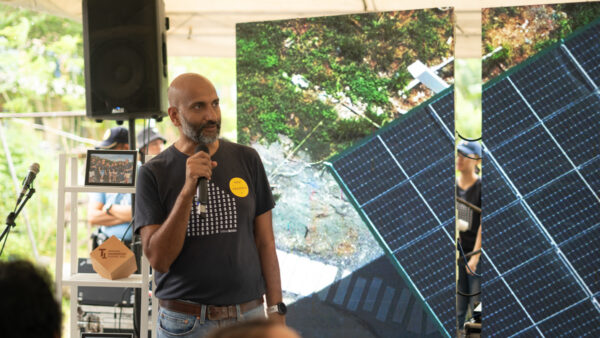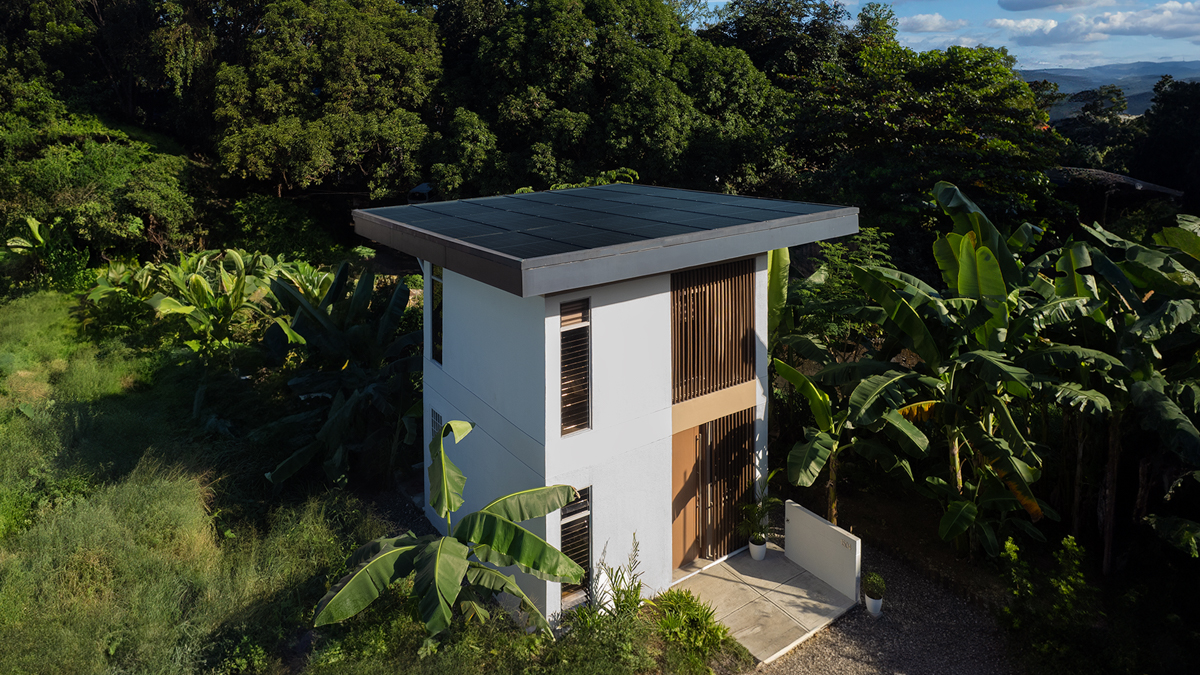A man with an ambitious plan targets the Philippines as a testing ground — and gets a dose of reality
Next month, a unique sustainable housing initiative in the Philippines will begin delivering affordable net-zero housing to low-income families, integrating solar energy to power the development and finance the project.
The Sienna Community is a 16-home development located in the Rizal hills just outside of Quezon City. The keys to the first two units will be handed over in May.
But for developer BillionBricks, and its CEO founder Prasoon Kumar, the journey to this launch has been bumpy — a five-year struggle against fixed mindsets, bureaucratic inertia, and business apathy. And for other sustainability entrepreneurs in Asia, it’s a cautionary tale.
The vision: A solar farm with a difference
Kumar is an architect by training and an urban planner by profession who spent the early part of his career in design and planning roles in the US, India, and Singapore. He founded BillionBricks in 2013 as a nonprofit that provided standalone emergency shelters and relief for thousands of displaced and homeless people across Asia.

BillionBricks CEO founder Prasoon Kumar
But one day he had an idea that would cause BillionBricks to make a dramatic pivot to a model for housing that would be affordable, sustainable — and permanent.
Underneath the solar panels would be another project — a development of low-cost, sustainable housing.
“I was on an aircraft, reading about solar farms and how they can break even in seven years, and I kind of linked that idea to housing, where the break-even is generally 25–30 years of mortgage payments.”
The broad strategy was to build a solar farm with a difference. Under a new for-profit spinoff, BillionBricks would go in as a developer, raise risk capital, procure land, and build a commercially viable sustainable energy business. But underneath those solar panels would be another project — a development of low-cost, sustainable housing for the poor. The panels would produce energy not only to service the project loan, they would also provide free energy for the homes and surrounding infrastructure.
A business plan that pencils out
Within the lifespan of a traditional mortgage, he calculated, the solar farm could produce enough surplus electricity to feed into the grid and repay the financiers, and also establish a net-zero living framework, one that could scale to millions of people across the developing world.
The developments are designed to be a net-zero and fully self-contained ecosystem, with all the necessary infrastructure incorporated into the model.
The design included systems to harvest rainwater and clean their own sewage, an EV charger as standard, and space to grow their own food.
In Kumar’s dream scenario, that framework of stability and financial support could help lift entire communities across the Global South out of poverty.
The reality from the trenches
BillionBricks was warmly received. People seemed to love the idea. Kumar managed to raise money and form partnerships with relative ease.
To date, the for-profit BillionBricks has raised about $4.5 million through project partnerships, grants, and equity. The biggest partner is Engie Factory, part of France’s ENGIE Group, a low-carbon energy and services company.
Kumar was approached by supporters from all over the world, and he identified at least a dozen countries where it seemed the regulatory and business environments were conducive to his model. He chose the Philippines as the pioneer destination. But he immediately ran into obstacles — legal, regulatory, financial, and insurance-related.
Novelty proves hard to sell, finance, and insure
One early issue was material use. “Our concrete is hyper-optimized” says Kumar, with houses that were designed to precise specifications to keep the use of concrete and steel reinforcement to a bare minimum. “But local contractors and engineers lack the knowledge to assess our system,” he says, and getting design approval proved problematic.
The design incorporated the solar panels as a structural component of the roof, but the regulators had never seen such a design.
Another roadblock was the solar panels themselves. The design incorporated the solar panels as a structural component of the roof, but the regulators had never seen such a design.
In these and other issues, the regulations did not specifically forbid the BillionBricks designs, but they did not explicitly allow them, and the regulators would tend to err on the side of caution.
“And even if you can convince (the regulators), the mortgage companies would only give lower loans on those houses because those techniques are not conventional and as a result, the appraisal values of houses on which people can take loans would be much lower.”
In one case, a 2,000-home development was set to break ground when the bank got cold feet. “The bank said if there’s a foreclosure it did not have the ability to sell a solar house because they had never sold one before. So they wanted Billion Bricks to guarantee it would rebuy the house.” The entire deal collapsed.
Related content:
A “sunshot” to energize the Global South without fossil fuels
Unleashing bamboo as a climate solution
Even where regulators and mortgage providers had been satisfied, insurers balked at issuing policies. And without insurance, the financiers pulled out.
“The system has been optimized to a certain set of standards and benchmarks, historical ones that just don’t include the stuff that (we’re) doing now because of the newness of it,” Kumar sighs. The world of sustainable innovation is agreeable enough when your model is a special project funded by grant money, but in the real world of cut-throat finance, the status quo wins every time.
Natural disaster strikes
Kumar is a pragmatic man, comfortable dealing with numbers and science. But his experiences have made him seriously consider whether the fates are having fun at his expense.
“I have a friend that’s a big believer in Indian planetary astrology and he really thinks I should go and see an astrologer. Because there’s no sense to the kind of challenges we are facing.”
Typhoons came and the bridges collapsed that led to [construction sites] and the lack of access not only halted construction it meant that prospective buyers were not able to come and view the development.
That suggestion came up after natural disasters in 2024 caused two of his projects to be halted. “Typhoons came and the bridges collapsed that led to both our sites.” The local authorities have been unable to rebuild the bridges, and the lack of access not only halted construction it meant that prospective buyers were not able to come and view the development, and so sales were put on hold. Twenty of 22 houses in the development remain unsold.
The way forward
Despite these frustrating experiences, he remains committed. May will see him deliver 2 of the 20 units under construction at the Sienna development. Each 45 square meter prefabricated modular home sold for 2.5 million PHP (about US$44,000), to buyers who secured mortgages from local banks. (The average annual income in the Philippines is 540,000 PHP, or about $9,500). Excess solar from the rooftop panels is sold to the grid, offsetting mortgage payments by as much as 20%.
Although they represent only a fraction of his ambition, these units represent progress, and Kumar is more determined than ever to deliver on his vision — to achieve proof of concept to the point where it can scale. “I genuinely feel that what I’m doing is not stupid. It should succeed, and I have the ability to overcome these challenges.”
Sharing lessons learned
In the meantime, he’s found he can make a difference in a different way: by speaking to and advising other pioneers and sustainability founders, and being very frank about the challenges and the obstacles that they, too, will face.
“My suggestion to most people today is to not do pioneering work. There are two different worlds. There’s the pioneering world of vision and innovation, and then there’s a real world of actual business.” he says.
His principal advice to sustainability entrepreneurs is this: be realistic in your ambitions.
Systemic issues, work culture, and ingrained practices are barriers for complex innovation everywhere, he says, and entrepreneurs need to tailor their vision to what’s achievable in the local context.
To bring the Sienna development to the delivery stage took political savvy and realism… and constant negotiation and compromise with local authorities.
Negotiate, compromise, and adjust the plan
To bring the Sienna development to the delivery stage took political savvy and realism. Constant negotiation and compromise with local authorities solved some problems, architectural redesign solved others. For instance, the plans to harvest rainwater have been shelved because, Kumar says, the idea proved simply too alien. Concrete use has been modified to satisfy local expectations.
But challenges also sparked creativity — and a new way to replace concrete in the wall structures.
“We are developing a walling system which would be 18% more material efficient than a standard wall system that’s typically used.” Borrowing from a practice in the auto industry, Kumar plans to make “panellized” walls by stamping steel into the required shapes.
And so he battles on. Kumar figures there’s another five years of grind and struggle ahead of him before he achieves the necessary scale to prove his point. That’s unless he finds an equally ambitious and visionary funding partner.
With $100 million, he says, he can prove his point much faster.
As he pursues more funding and refines his approach to sustainable, affordable, and scalable housing, Kumar says he’s mulling a visit to that astrologer after all, just for good measure.
“Just imagine for a moment if we succeed. What would it do for the world?”


